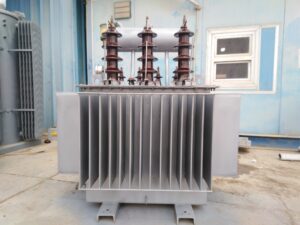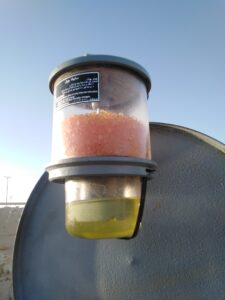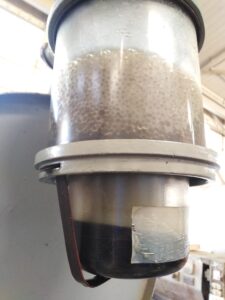Oil-immersed transformers have a simple system called a transformer breather!
This system lets the transformer oil expansion process happen during load peaks. Let’s discuss transformer breather in this article.
Table of Contents
What is a Transformer Breather?

A “Transformer Breather” refers to a component used in electrical transformers to manage changes in the volume of oil or insulating liquid inside the transformer tank due to temperature variations.
Transformers are essential in the electrical distribution and power transmission systems to step up or step down voltage levels. They consist of a core and coils immersed in insulating oil or liquid to dissipate heat generated during operation.
The insulating oil within the transformer tank can expand and contract with temperature changes, which can lead to the creation of a vacuum or pressure inside the tank.
To prevent excessive pressure buildup or the entry of air and moisture into the transformer, a transformer breather is used.
A transformer breather typically consists of a cylindrical container filled with a moisture-absorbing desiccant material, such as silica gel. This container is connected to the transformer tank through a pipe.
When the transformer oil contracts due to lower temperatures, the air is drawn into the transformer tank through the breather, passing through the desiccant material, which removes moisture from the incoming air. Conversely, when the oil expands as temperatures rise, excess air inside the tank is expelled through the breather.
By regulating the exchange of air with the outside environment and removing moisture, a transformer breather helps maintain the integrity of the insulating oil and prevents the formation of moisture-related problems, such as dielectric breakdown or the formation of sludge and corrosive compounds within the transformer.
In summary, a transformer breather is a vital component in electrical transformers that helps manage the volume of insulating oil and maintain its quality by controlling the exchange of air and moisture with the surrounding environment.
What is the transformer breathing Process?
The transformer breathing process, also known as the “breather operation” in electrical transformers, is a crucial mechanism for managing changes in the volume of insulating oil or liquid inside the transformer tank due to temperature variations.
This process helps maintain the integrity of the transformer’s insulation system and prevents the entry of moisture and air, which can degrade the transformer’s performance and longevity.
Here’s a step-by-step explanation of the transformer breathing process:
-
Temperature Change: Transformers experience temperature variations during normal operation. When the transformer’s temperature rises, the insulating oil inside the tank expands, and when the temperature drops, the oil contracts.
-
Breather Installation: A transformer breather is installed on the transformer tank. The breather typically consists of a cylindrical container filled with a moisture-absorbing desiccant material, such as silica gel. The breather is connected to the transformer tank through a pipe.
-
Expansion and Contraction: As the oil inside the transformer tank expands due to higher temperatures, it creates excess pressure inside the tank. Conversely, as the oil contracts due to lower temperatures, it creates a vacuum inside the tank.
-
Air Exchange: When the transformer experiences an increase in temperature and pressure inside the tank, the breather allows ambient air to be drawn into the transformer through the desiccant material. This incoming air passes through the desiccant, removing moisture and other impurities. The desiccant acts as a drying agent, preventing moisture from entering the transformer.
-
Pressure Release: When the transformer’s temperature drops, causing the oil to contract and create a vacuum inside the tank, the breather allows excess air from inside the tank to be expelled. This prevents the tank from collapsing due to the vacuum and ensures that the internal pressure remains within safe limits.
-
Moisture Control: The desiccant material in the breather continues to absorb moisture from the incoming air, ensuring that the insulating oil remains dry and free from contaminants. This helps maintain the dielectric properties of the oil and prevents moisture-related issues.
A small amount of transformer oil is used in a small cab in the breather. Let’s find out why.
Why is Transformer Oil Used in Breather?

A simple, but effective protection method, for both transformer oil and silica gel, is using an oil cap, or transformer breather oil cup, at the bottom of a breather, and serves two purposes.
- Firstly, it absorbs the dust particles that are present in the air during the breathing process.
- Secondly, it acts as a barrier between silica gel and air when there is no breathing in or out.
Do All Transformers Have Breathers?
Not all transformers require breather and conservator tanks.
Breathers are required for transformers in which the breathing in and out can cause the oil to come out of the transformer.
Dry type transformers has no oil and then no breather is required. Also hermetically sealed transformers are without breather. These type of transformers are completely sealed and has no connection to outside atmosphere.
For heat dissipation, Corrugated fins are used instead of breathers. Corrugated fins have enough flexibility to allow space for oil expansion
Similarly, Current Transformers (CT) and Potential Transformers (PT) which are dry type transformers, there is no need of breathers as temperature inside the transformers remains within the limit, and require no oil.
This leads us to another type of transformer oil protection system called hermetically sealed transformers. Let’s know more about it!
Why does Hermetically Sealed Transformers require no breather?
Hermetically sealed transformers have no contact with the outside environment. These transformers are designed without any conservator tank, breather, or silica gel.
Hermetically sealed transformers require no breather because, their sealing is done in such perfection that, the oil expansion is allowed within the transformer body.
The absence of the transformer breather makes the use of these transformers very common in environments where rain or snow percentage is quite high, also environments with high levels of gases in the air, and placing a transformer with a breather outside could cause destructive for transformer’s life.
Is Silica Gel Effective in Transformer Breather?

A silica gel breather is a way to allow the oil expansion and at the same time to prevent moisture from entering the transformer.
Breather and Silica Gel protect the oil from moisture during transformer breathing.
Silica gel plays the main role in protecting transformer oil from moisture. It has a great ability to absorb moisture from air and pass it on to the dry air only into the transformer tank. So, it is effective and does its role perfectly.
Silica gel in the transformer breather changes its color if it adsorbs moisture and water, so we are indicated to replace it.
Silica Gel Colors:
White silica gel: this is a non-indicating silica gel, which means no color change will happen if it adsorbs water.
Blue silica gel: This type of silica gel has cobalt chloride which changes its color to to be pink after adsorbing water. When it becomes pink this means it reached its adsorption maximized capacity.
Orange silica gel: This is another color indicating type which is suitable to be used in silica gel breather of transformers.
How does the moisture is controlled in transformers breather?
A breather fitted on power transformers is designed to control moisture by using a desiccant material to absorb moisture from the air entering the transformer tank.
Here’s how the moisture control process works:
-
Desiccant Material: The breather contains a desiccant material, commonly silica gel, which has a high affinity for moisture. Silica gel is a porous substance that can absorb and hold a significant amount of water vapor.
-
Air Exchange: As the temperature changes, causing the oil volume within the transformer tank to expand and contract, the breather allows for the exchange of air between the transformer tank and the external environment. When the transformer oil heats up and expands, it creates excess pressure inside the tank, causing the breather to allow external air to be drawn in.
-
Moisture Absorption: When the external air enters the breather, it passes through the desiccant material. The desiccant absorbs moisture from the incoming air, effectively drying the air before it enters the transformer tank. Any moisture present in the air is trapped by the silica gel, preventing it from entering the transformer and contaminating the insulating oil. Read my article Moisture and transformer oil- a deadly combination!
-
Protection Against Moisture: The desiccant material continues to absorb moisture from the incoming air over time. This ongoing moisture absorption helps maintain the dryness of the air inside the transformer tank. Dry air is essential for preserving the dielectric properties of the insulating oil and preventing the formation of sludge, corrosion, and other moisture-related issues.
-
Indicator System: Transformer breathers often include an indicator system to monitor the condition of the desiccant material. The indicator changes color or provides a visual signal when the desiccant becomes saturated with moisture. When the indicator signals that the desiccant is saturated, it’s time to replace or regenerate the desiccant to maintain effective moisture control.
By using a desiccant-filled breather, power transformers can effectively control moisture levels inside the transformer tank, ensuring the integrity and performance of the insulating oil and preventing moisture-related problems that can lead to transformer failure.
Regular maintenance, such as monitoring and replacing or regenerating the desiccant when needed, is essential to ensure the breather’s continued effectiveness in moisture control.
Why prevent moisture from entering into a transformer?
If the transformer breather has no silica gel to absorb moisture from the air which comes from the outside atmosphere, then transformer oil may contain water particles, which decreases its insulation.
Passing air through the silica gel ensures that only dry air enters the transformer. and protects transformer oil. The oil insulation degree decreases to a bad situation if it contains water, that is why we use silica gel.
I have written a detailed article about transformer moisture causes and solutions.
When Should I Replace Transformer Silica Gel?

It is recommended to change the silica gel at 1/3 stage of saturation because waiting for complete saturation could lead to some moisture transferring inside the transformer.
Silica Gel keeps on absorbing moisture from the air flowing inside the conservator until it reaches a saturation point.
The saturation point comes at different times for different transformers, but the principle of saturation is the same.
Moisture starts from the bottom of the breather and keeps going upward, moisturizing all the silica present in the container.
For Orange silica gel, the saturation level changes the color to transparent, whereas in purple silica, the saturation color would be pink.
If the silica gel is absorbed by the oil, especially after a fault like the one in the photo, you should replace it. In this case, silica gel becomes bad.
The photo is of one 500KVA transformer in my workplace, it had a short circuit and the oil came out of the transformer through the silica gel breather. The silica gel became bad.
Can I reuse absorbed silica gel?
General advice is to at least maintain 2-4 inches of silica buffer dry. However, replacing silica is not necessary always, because the alternative option of drying out the moisture through the specific levels of heat is more cost-efficient.
Drying silica gel is usually done under a temperature of 60°C for about 6 hours. In case of absorbing oil, silica gel can’t be reused again, and should be replaced.
How to Replace Power Transformer Silica Gel?
The conventionally used process for replacing silica gel from power transformers involves the following steps:
- The first thing is to remove the conservator from the transformer and take out all the absorbent silica Gel present inside it.
- The second step involves cleaning the glass cover to remove any dirt attached.
- In the next step, new silica gel is filled into the conservator. At this stage, it is preferred to use silica gel without any color impurities, for monitoring the performance of the absorber.
- Finally, transformer oil used for absorbing impurities is poured into the seal cup attached to the conservator. The level of oil is carefully maintained to the safe limit.
Can We Change the Silica Gel of the Energized Transformer?
I recommend never changing silica gel while the transformer is energized, especially for power transformers, for safety purposes.
However, in some cases, experienced electricians can do this job while the transformer is in service.
The main point to take into consideration is the safe distance between the breather and the power lines of the transformer. Besides, the expertise of the person is a vital key too.
Also, I never recommend doing this job during windy days and high moisture hours of the day. In general, it’s better to do the job indoors i.e. inside a workshop if possible.
Install my Free Android App on Google Play:
Electrical Cables Most Common Tables “Electrical Cables Tables”
And, my Electrical Calculations App “Fast Electrical Calculator”
Discover more great content by subscribing to My channel
Looking to stay ahead of the game in the world of electrical engineering? Subscribe to my YouTube channel and gain access to exclusive content you won’t find anywhere else!
The staff I recommend
(Amazon Affiliate Links to products I believe are high quality):
- Economy 120 Volt/60Hz AC Power Source – Step-Down Voltage & Frequency Converters 1800W
- UNI-T Digital Multimeter Tester UT139C
- 50-Amp Extension Cord for RV “100ft”
- Voltage Stabilizer 110/220v
- Hair Dryer “best selling“
- TOSHIBA EM131A5C-BS Countertop Microwave Ovens
Disclaimer: This contains affiliate links to Amazon products. I may earn a commission for purchases made through these links.


